How to Organize a Walk-in Closet Like a Pro | Expert Tips

Before you can dream of a beautifully organized walk-in closet, there’s one step you absolutely cannot skip: a complete, no-holds-barred cleanout. This isn't just about tidying up; it's about editing your wardrobe down to the things you actually love and wear. This initial reset is the real secret to creating an organized space that actually stays that way.
Start with a Ruthless Closet Reset
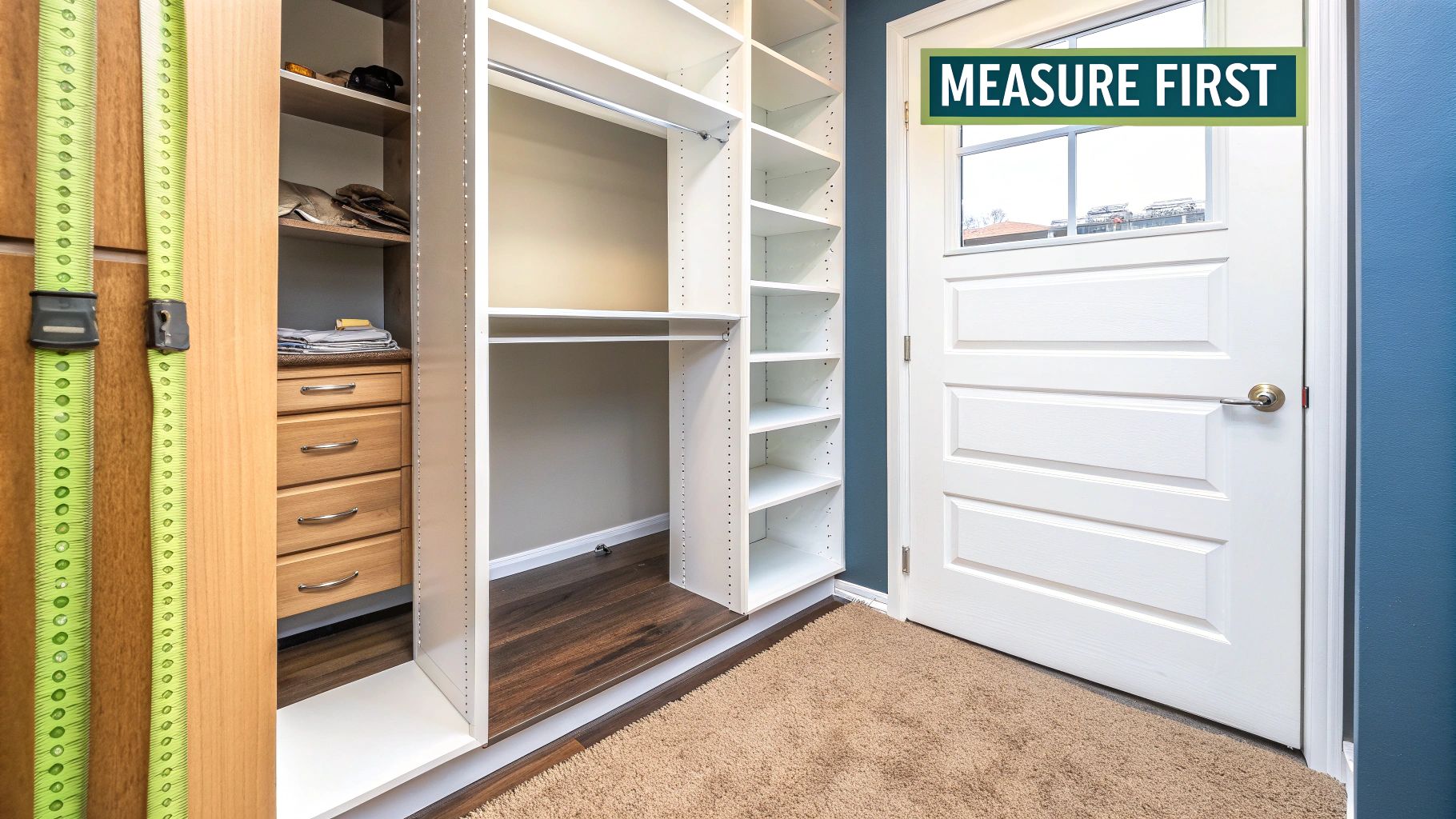
The path to an organized closet doesn’t begin with buying fancy bins and matching hangers. It starts by creating a blank canvas so you can see the space for what it truly is. And the only way to do that is to take everything out.
Yes, everything. Every shirt, every pair of shoes, every forgotten scarf—it all has to come out. Pile it on your bed or lay a clean sheet on the floor. Seeing your entire wardrobe in one giant heap is a powerful, eye-opening experience. It’s often the exact motivation you need to start making some tough but necessary decisions.
Create Your Sorting System
Once you're facing that mountain of clothes, it's time to sort. This is a crucial moment for an honest check-in on your personal style and what you really need. Set up four distinct zones using laundry baskets, boxes, or just different corners of the room:
- Keep: These are your non-negotiables. The clothes you wear all the time, that fit perfectly, and make you feel fantastic.
- Donate: Anything in good, wearable condition that just isn't "you" anymore. Maybe it doesn't fit, or your style has simply changed.
- Sell: This is for your higher-value pieces that are in great shape but you no longer reach for. Think designer items, formal dresses, or brand-name jackets.
- Discard: For items that are truly at the end of their life—stained, ripped, or too worn to be passed on.
As you pick up each piece, be honest with yourself. Your closet is prime real estate for your daily life, not a storage unit for memories or guilt.
Ask the Tough Questions
To cut through the clutter, ask yourself two direct questions about anything you're on the fence about:
Have I worn this in the last 12 months? If the answer is no (special occasion wear being the rare exception), it’s a clear sign it’s time to let it go. Be realistic about the life you live today.
Would I buy this today if I saw it in a store? This question is a game-changer. It strips away emotional attachment and forces you to see the item for what it is. If you wouldn't spend money on it now, why is it taking up space in your closet?
Getting this first part right is the most important thing you can do. If you need more guidance on this initial purge, our guide on how to declutter your closet has even more tips. By clearing out what you don't need, you create a space filled only with things you value, making the whole organization process more rewarding.
Design a Closet That Works for You
Now that you've decluttered your wardrobe, it's time to create a closet layout that truly fits your clothes and your life. The goal is to create a functional, intuitive space that makes getting ready in the morning a breeze.
First, grab a tape measure. You need to know exactly what you're working with, so measure the width, depth, and height of your closet walls. Sketching a quick floor plan on a piece of paper is incredibly helpful for figuring out what will actually fit before you start buying storage systems.
Create Intuitive Closet Zones
The best-organized closets all have one thing in common: logical zones. By grouping similar items together, you create a natural flow that makes finding things almost second nature.
Here are a few zoning ideas to get you started:
- Workwear: Keep all your blazers, dress pants, and blouses in one prime, easy-to-reach spot for busy weekday mornings.
- Weekend & Casual: Group your favorite jeans, t-shirts, and comfy sweaters together for effortless off-duty style.
- Formal & Occasion Wear: That cocktail dress or suit you only wear a few times a year? Give it a home in a less prominent area, like the back of the closet.
- Activewear: Store your leggings, workout tops, and gym shorts together so you can grab them and go.
This simple act of zoning transforms a chaotic collection of clothes into a well-oiled machine.
Choose the Right Closet System
The closet organization market is bigger than ever. In fact, it was valued at around USD 7.64 billion and is projected to hit USD 14.57 billion by 2032. With major players like IKEA and The Container Store offering fantastic modular systems, you have plenty of options. For a deeper dive, you can explore various strategies on how to design a closet to figure out what fits your budget and style.
The image below shows a typical outcome after a big closet clean-out, which is crucial for planning your new setup.
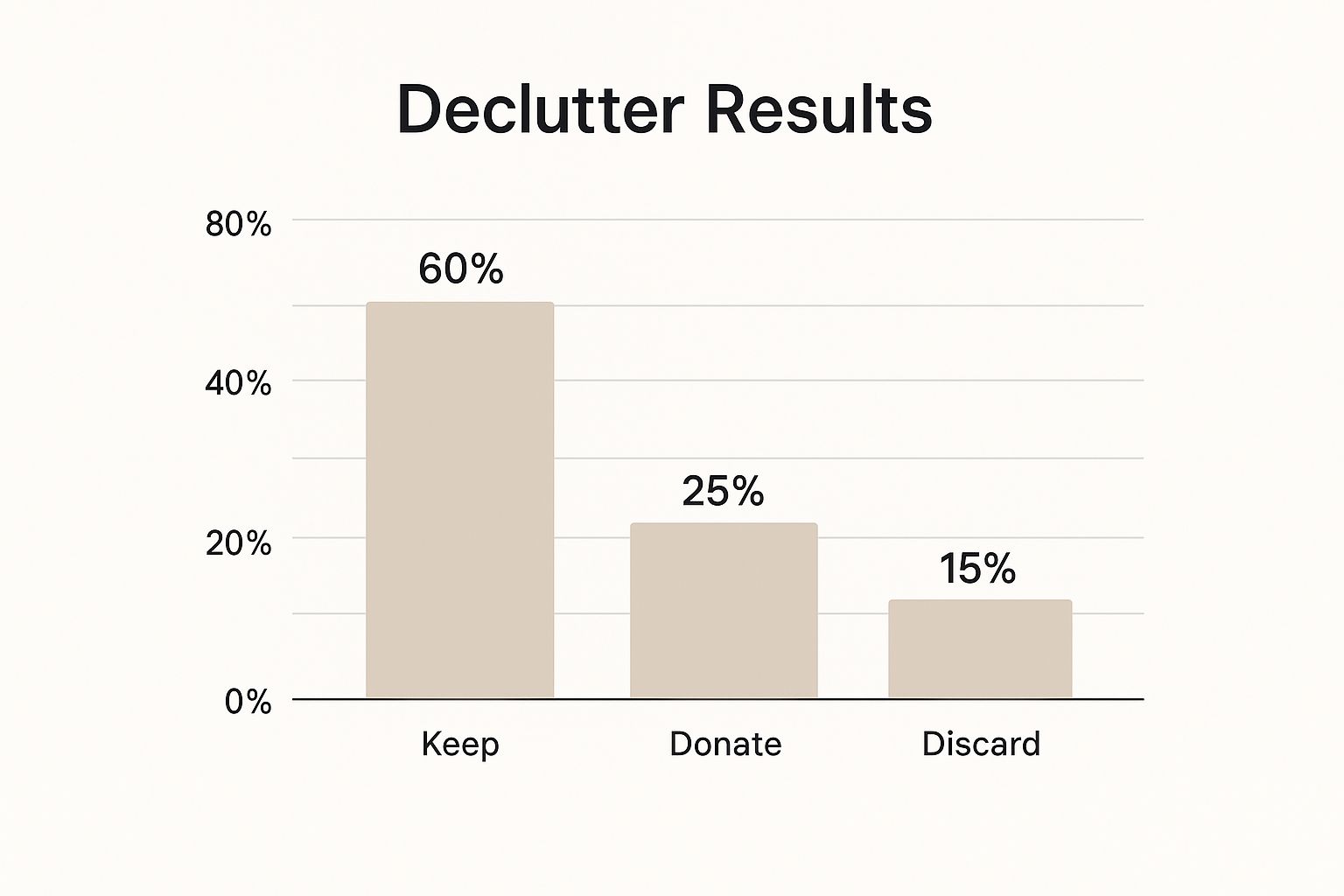
As you can see, you’re likely planning for about 60% of what you started with. This makes it so much easier to map out exactly how much shelving, drawer space, and hanging room you'll need.
Now, let's talk about ergonomics. The key to a truly user-friendly closet is placing your most-used items right at eye level—somewhere between your shoulders and knees. Things you don't reach for as often, like out-of-season clothes or formal shoes, can be stored up high or down low.
Pro Tip: Double hanging rods are a game-changer. You can instantly double your hanging space for shirts, skirts, and pants. Reserve a section with a single, taller rod for long dresses, jumpsuits, and coats.
Closet System Comparison
Choosing the right system can feel overwhelming, but it really comes down to your budget, customization needs, and what you're storing. Here’s a quick breakdown of the most common options to help you decide.
| System Type | Average Cost | Customization Level | Best For |
|---|---|---|---|
| Wire Shelving | $100 - $400 | Low | Budget-conscious organizers, renters, and basic storage needs. |
| Modular Systems (e.g., IKEA PAX) | $500 - $2,000 | Medium | DIY enthusiasts who want a custom look without the high price tag. |
| Wall-Mounted/Track-Based | $800 - $3,000 | High | Adjustability and changing needs; great for kids' closets that need to adapt. |
| Custom Built-In Cabinetry | $3,000 - $10,000+ | Very High | Homeowners looking for a permanent, high-end, fully integrated solution. |
Ultimately, the best system is the one that fits your space and makes your daily routine smoother.
Select Smart Storage and Organizers
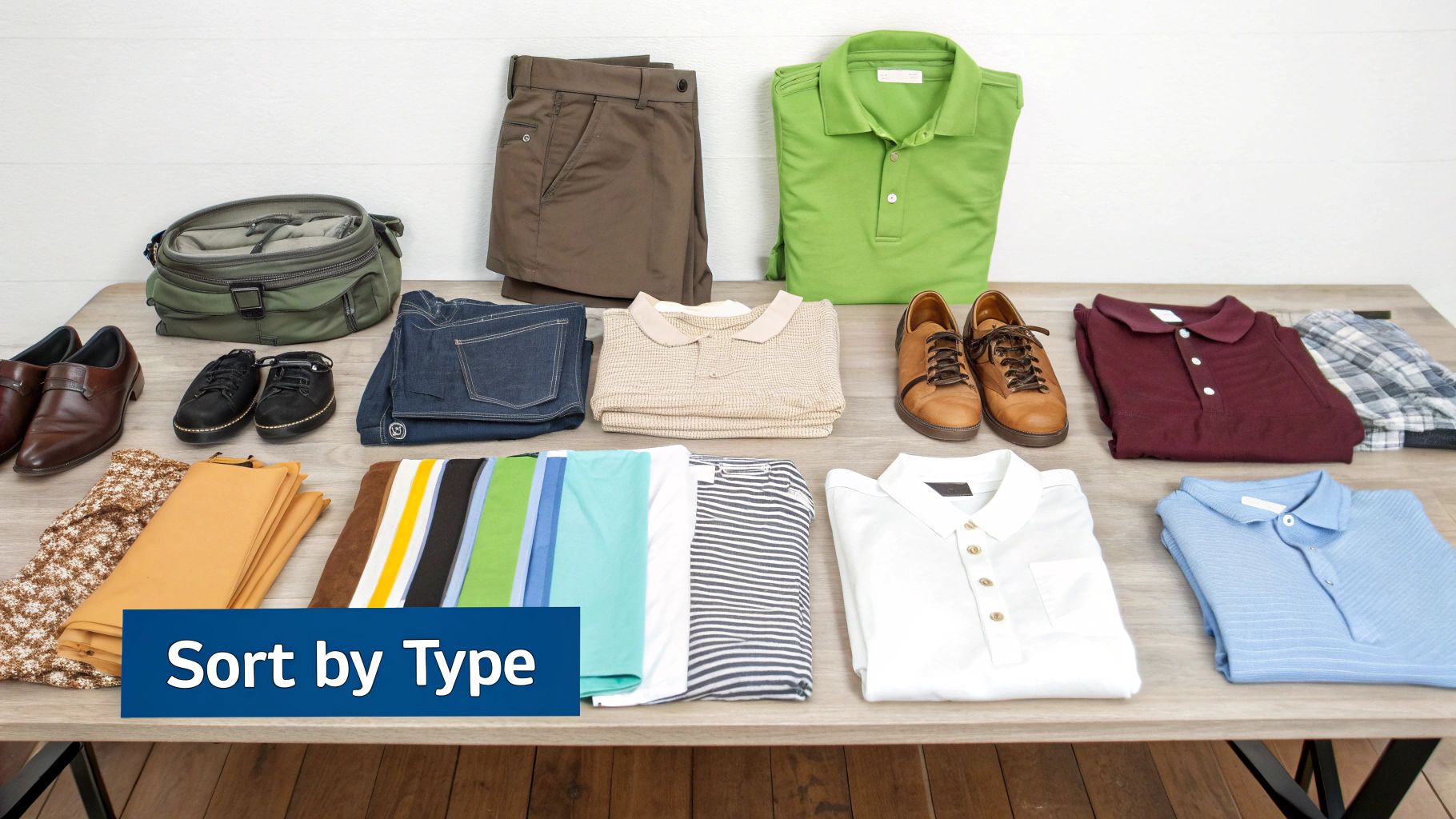
Now that you have a clean slate and a solid layout, it's time to pick the right tools to make your dream closet a reality. This is about being strategic and choosing organizers that solve real problems and make the most of every last inch.
The single biggest—and most immediate—impact you can make is with your hangers. A messy mix of plastic, wire, and bulky wooden hangers not only looks chaotic but also eats up a shocking amount of rod space.
Switch to a uniform set of slim, non-slip velvet hangers. It instantly creates a streamlined, high-end look and can boost your hanging space by up to 30%.
Divide and Conquer Your Shelves and Drawers
Open shelves often become magnets for clutter. That perfectly folded stack of sweaters quickly turns into a messy pile. This is where shelf dividers are a game-changer. Simple acrylic or metal dividers slide right onto shelves, creating neat, separate cubbies for folded clothes and preventing everything from toppling over.
The same goes for your drawers. Without structure, they become a jumble of socks, belts, and accessories. Pop in some adjustable drawer dividers or honeycomb-style inserts. They create a dedicated spot for every little thing, so you can see exactly what you have in a single glance.
When you give every single item a specific home—from belts and scarves to t-shirts and socks—you're building a system that removes stress and makes getting ready feel calm and effortless.
Maximize Vertical and Floor Space
It's easy to forget to look up and down, but that's where you'll find a goldmine of unused space. The floor, for instance, often becomes a dumping ground for shoes. A simple tiered or vertical shoe rack can easily double, or even triple, your storage capacity without expanding its footprint.
For all those seasonal items you don't need every day, like heavy winter coats or formal wear, clear storage bins are your best friend.
- Go For Clear Bins: Being able to see what’s inside without pulling down a whole stack is a huge time-saver.
- Label Everything: Even if the bin is clear, a quick label makes finding what you need that much faster.
- Use the Top Shelf: Stash these bins on the highest shelf to keep them out of your prime, everyday-use zones.
Finally, what about all those extra hangers? Don't let them become a tangled mess. Learning a few clever methods for how to store hangers is a small detail that keeps the entire space looking polished.
Put Everything Back with Intention
Alright, the hard part is over. Your closet is clean, your new storage is in place, and now for the most satisfying step: putting your wardrobe back into its new home. This isn’t just about refilling the space; it’s about creating a system that makes getting dressed every morning easier.
The key to a functional closet is how you arrange your clothes. A time-tested method is to group all like items together. Keep all your blouses in one section, your pants in another, and your dresses all in a row. This creates immediate visual clarity and stops the frantic search for that one specific top.
Once you have your categories, you can add another layer of order by sorting each section by color. Creating a gradient from light to dark—like a rainbow—not only looks incredible, giving your closet that high-end boutique feel, but it also makes coordinating outfits practically effortless.
Prioritize Your Prime Real Estate
Think about your closet the way a grocery store plans its aisles. The most popular items are always right at eye level, easy to grab. You should apply this same "prime real estate" principle to your wardrobe. Your everyday go-to items—the jeans, shirts, shoes, and accessories you wear constantly—should be front and center, positioned between your shoulders and your knees.
Items you wear less often, like that cocktail dress or the heavy winter coats you've stored in bins, can go on the higher shelves or in the lower drawers. This simple strategy keeps your daily essentials within easy reach, which is the secret to making your new system stick.
Your most accessible closet space is valuable. By reserving it for your everyday favorites, you’re creating a system that works with your habits, not against them.
Handle Your Items with Care
How you store your clothes can make a big difference in how long they last. While hangers are fantastic for most things, they can be the enemy of others. Heavy sweaters and delicate knits, for example, will stretch and lose their shape if left on a hanger for too long.
Here are a few guidelines to keep your clothes in great condition:
- Fold Your Knitwear: Always fold your sweaters, chunky cardigans, and other knits. Stack them neatly on shelves (those new dividers will come in handy here!) or place them in drawers.
- Use Vertical Space for Accessories: Don't let your accessories become a tangled mess. Use dedicated hooks or specialized vertical hangers for scarves, belts, and purses to keep them visible and in good shape.
- Hang Pants Properly: To prevent ugly creases, fold pants over the bar of a sturdy hanger. You can also use clip hangers to hang them vertically by the waistband.
This kind of attention to detail is becoming more common. As people invest more in functional homes, the global market for clothes closets is projected to hit US$40.37 billion. This growth is driven by the demand for smart, well-designed storage, which you can read more about in this clothes closet market report.
Keeping Your Organized Closet That Way for the Long Haul
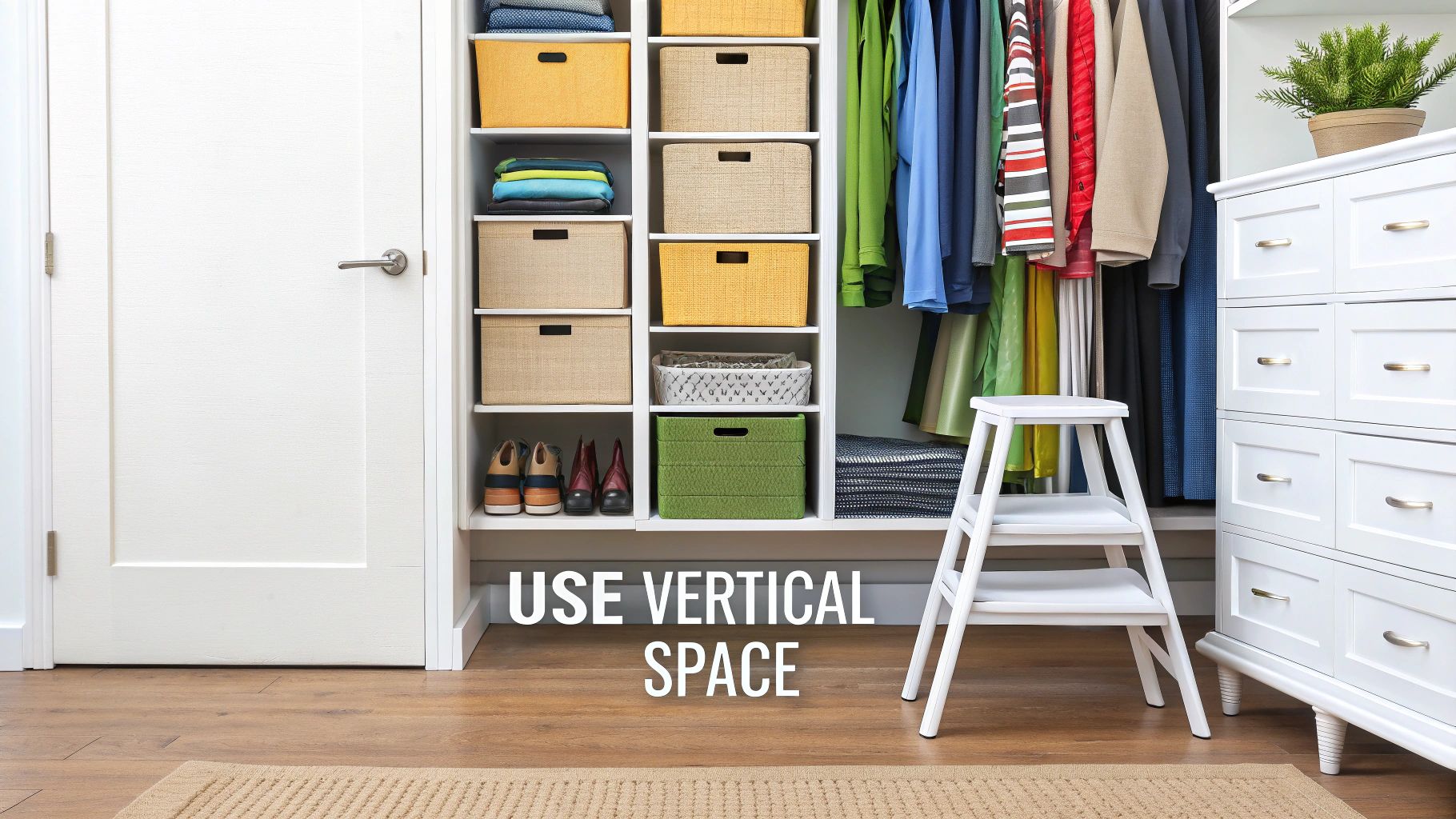
You've purged, planned, and arranged everything, and your walk-in closet is finally a space you can be proud of. But getting organized is one thing; staying organized is the real challenge.
The good news? It doesn't take another full weekend overhaul to keep things in check. The secret is building a few small, effortless routines that prevent the clutter from ever creeping back in.
Little Habits Make a Big Difference
The key to keeping that freshly-organized feeling is to weave tiny resets into your weekly schedule. These aren't massive chores, just quick actions that stop the mess before it starts.
Here are a couple of non-negotiable habits:
- The 'One-In, One-Out' Rule: This is a classic for a reason—it works. Whenever you buy a new shirt, an old one has to go. This simple transaction keeps your wardrobe from slowly swelling until your hangers are crammed together again.
- The 10-Minute Weekly Tidy-Up: Set aside just 10 minutes every Sunday evening to do a quick reset. Hang up clothes, put your shoes back where they belong, and quickly refold any messy stacks.
This quick weekly tidy is your secret weapon. It stops little piles from turning into an overwhelming project, keeping your closet a calm, functional space all the time.
Make Seasonal Swaps Painless
You don't need your heavy winter coats taking up prime real estate in July. A seasonal swap-out is the best way to keep your closet relevant and uncluttered, but it doesn't have to be a dreaded, day-long event.
The trick is to make it easy on your future self. Store off-season clothes in clear, labeled bins so you know exactly what’s in them. For bulky items like puffers and wool sweaters, vacuum-sealed bags are a game-changer; they shrink everything down to a surprisingly small size.
Tuck these bins away on a high shelf or in a guest room closet. When the weather turns, you’re just doing a simple switcheroo, not a major excavation.
Create a Space You Want to Be In
You’re more likely to keep a space tidy if you genuinely enjoy being in it. A few small upgrades can transform your closet from a simple storage area into a little personal sanctuary, which is a huge motivator for keeping it neat.
Think about adding a few simple touches:
- Better Lighting: Ditching that single, dim bulb for bright LED strip lighting makes a world of difference.
- A Full-Length Mirror: It’s practical for checking your outfit and makes the space feel bigger and more intentional.
- A Touch of Luxury: This could be as simple as a small, soft rug underfoot, a beautiful tray for your jewelry, or a cedar sachet to keep things smelling fresh.
When your closet feels less like a chore and more like your own personal boutique, you'll naturally want to keep it looking its best.
Frequently Asked Questions About Organizing a Walk-In Closet
Organizing a walk-in closet is a major project, so it's completely normal for questions to come up. Let's tackle some of the most common hurdles.
What Should I Do If I'm Overwhelmed?
It happens to the best of us. You pull everything out, see that mountain of clothes, and the urge to just shove it all back in is powerful. When you feel that overwhelm creeping in, stop thinking about the entire project and just focus on one small, manageable task.
Don't try to conquer the whole closet in a single weekend. Break it down into mini-tasks:
- Day 1: Just deal with the shoes.
- Day 2: Move on to your hanging clothes.
- Day 3: Tackle your drawers or accessories.
This method keeps you moving forward without the paralysis that comes from staring at a massive, messy project. Remember, any progress is good progress.
How Can I Organize My Closet on a Tight Budget?
A beautifully organized closet doesn't have to come with a hefty price tag. The single most effective step you can take is completely free: decluttering. Getting rid of what you don't need is the fastest way to reclaim precious space.
Once you’ve pared down, you can focus on smart, low-cost solutions. Simple shelf dividers, basic drawer inserts, and over-the-door hooks can work wonders. The best bang for your buck, though? Switching to a uniform set of slim, space-saving hangers. It’s an inexpensive fix that instantly creates more room and makes your closet look ten times better.
The goal is a functional system that makes your life easier, not a designer showroom. You can always add fancier elements later, but getting the basic structure right is what really counts.
Are Smart Closets Worth the Investment?
The demand for walk-in closets is booming, with the market projected to double from USD 11.1 billion to USD 22.3 billion. A part of that growth is driven by tech integration, with about 18% of new installations featuring things like app-controlled lighting or automated racks. You can learn more about the growing walk-in closet market to see where the industry is headed.
So, are they worth it? For most of us, these high-tech features are a "nice-to-have," not a necessity. If you have an enormous wardrobe or need help with accessibility, an automated rack could be a game-changer. But for everyone else, your time and money are better spent mastering the fundamentals of good organization.
Ready to take your closet from chaotic to calm? It all starts with the right hangers. MORALVE designs a complete range of space-saving hangers that maximize every inch of your closet and create that clean, streamlined look you’ve been dreaming of. Explore our innovative closet solutions today!
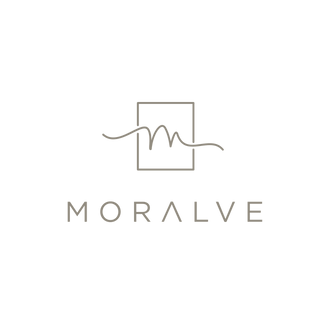

Leave a comment